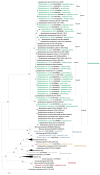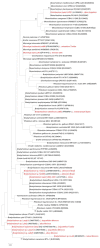Lupin, a Unique Legume That Is Nodulated by Multiple Microsymbionts: The Role of Horizontal Gene Transfer
- PMID: 37047476
- PMCID: PMC10094711
- DOI: 10.3390/ijms24076496
Lupin, a Unique Legume That Is Nodulated by Multiple Microsymbionts: The Role of Horizontal Gene Transfer
Abstract
Lupin is a high-protein legume crop that grows in a wide range of edaphoclimatic conditions where other crops are not viable. Its unique seed nutrient profile can promote health benefits, and it has been proposed as a phytoremediation plant. Most rhizobia nodulating Lupinus species belong to the genus Bradyrhizobium, comprising strains that are phylogenetically related to B. cytisi, B. hipponenese, B. rifense, B. iriomotense/B. stylosanthis, B. diazoefficiens, B. japonicum, B. canariense/B. lupini, and B. retamae/B. valentinum. Lupins are also nodulated by fast-growing bacteria within the genera Microvirga, Ochrobactrum, Devosia, Phyllobacterium, Agrobacterium, Rhizobium, and Neorhizobium. Phylogenetic analyses of the nod and nif genes, involved in microbial colonization and symbiotic nitrogen fixation, respectively, suggest that fast-growing lupin-nodulating bacteria have acquired their symbiotic genes from rhizobial genera other than Bradyrhizobium. Horizontal transfer represents a key mechanism allowing lupin to form symbioses with bacteria that were previously considered as non-symbiotic or unable to nodulate lupin, which might favor lupin's adaptation to specific habitats. The characterization of yet-unstudied Lupinus species, including microsymbiont whole genome analyses, will most likely expand and modify the current lupin microsymbiont taxonomy, and provide additional knowledge that might help to further increase lupin's adaptability to marginal soils and climates.
Keywords: 16S rRNA; Bradyrhizobium; Lupinus; horizontal gene transfer; nifH; nodC; rhizobia; symbiotic genes.
Conflict of interest statement
The authors declare no conflict of interest.
Figures



Similar articles
-
Diverse Bacteria Affiliated with the Genera Microvirga, Phyllobacterium, and Bradyrhizobium Nodulate Lupinus micranthus Growing in Soils of Northern Tunisia.Appl Environ Microbiol. 2017 Mar 2;83(6):e02820-16. doi: 10.1128/AEM.02820-16. Print 2017 Mar 15. Appl Environ Microbiol. 2017. PMID: 28062461 Free PMC article.
-
Insights into the Phylogeny, Nodule Function, and Biogeographic Distribution of Microsymbionts Nodulating the Orphan Kersting's Groundnut [Macrotyloma geocarpum (Harms) Marechal & Baudet] in African Soils.Appl Environ Microbiol. 2019 May 16;85(11):e00342-19. doi: 10.1128/AEM.00342-19. Print 2019 Jun 1. Appl Environ Microbiol. 2019. PMID: 30952658 Free PMC article.
-
Phylogenetic and symbiotic diversity of Lupinus albus and L. angustifolius microsymbionts in the Maamora forest, Morocco.Syst Appl Microbiol. 2022 Jul;45(4):126338. doi: 10.1016/j.syapm.2022.126338. Epub 2022 May 27. Syst Appl Microbiol. 2022. PMID: 35660736
-
Specificity in Legume-Rhizobia Symbioses.Int J Mol Sci. 2017 Mar 26;18(4):705. doi: 10.3390/ijms18040705. Int J Mol Sci. 2017. PMID: 28346361 Free PMC article. Review.
-
Genetic diversity of rhizobia associated with root nodules of white lupin (Lupinus albus L.) in Tunisian calcareous soils.Syst Appl Microbiol. 2019 Jul;42(4):448-456. doi: 10.1016/j.syapm.2019.04.002. Epub 2019 Apr 13. Syst Appl Microbiol. 2019. PMID: 31031015 Review.
Cited by
-
The Beneficial Effects of Inoculation with Selected Nodule-Associated PGPR on White Lupin Are Comparable to Those of Inoculation with Symbiotic Rhizobia.Plants (Basel). 2023 Dec 8;12(24):4109. doi: 10.3390/plants12244109. Plants (Basel). 2023. PMID: 38140436 Free PMC article.
-
Microbial Colonization of the Host Plant: Cellular and Molecular Mechanisms of Symbiosis.Int J Mol Sci. 2024 Jan 4;25(1):639. doi: 10.3390/ijms25010639. Int J Mol Sci. 2024. PMID: 38203809 Free PMC article.
-
Multilocus sequencing analysis of the rhizobial symbionts isolated from Acacia salicina (Lindl.) grown in different regions in Tunisia reveals putative novel Bradyrhizobium species.World J Microbiol Biotechnol. 2024 Dec 30;41(1):22. doi: 10.1007/s11274-024-04236-z. World J Microbiol Biotechnol. 2024. PMID: 39738700
-
Cyclic Isothiocyanate Goitrin Impairs Lotus japonicus Nodulation, Affects the Proteomes of Nodules and Free Mesorhizobium loti, and Induces the Formation of Caffeic Acid Derivatives in Bacterial Cultures.Plants (Basel). 2024 Oct 16;13(20):2897. doi: 10.3390/plants13202897. Plants (Basel). 2024. PMID: 39458844 Free PMC article.
-
Microvirga sesbaniae sp. nov. and Microvirga yunnanensis sp. nov., Pink-Pigmented Bacteria Isolated from Root Nodules of Sesbania cannabina (Retz.) Poir.Microorganisms. 2024 Jul 30;12(8):1558. doi: 10.3390/microorganisms12081558. Microorganisms. 2024. PMID: 39203400 Free PMC article.
References
-
- Azani N., Babineau M., Bailey C.D., Banks H., Barbosa A.R., Pinto R.B., Boatwright J.S., Borges L.M., Brown G.K., Bruneau A., et al. A new subfamily classification of the Leguminosae based on a taxonomically comprehensive phylogeny. Taxon. 2017;66:44–77. doi: 10.12705/661.3. - DOI
-
- Peix A., Ramírez-Bahena M.H., Velázquez E., Bedmar E.J. Bacterial associations with legumes. CRC Crit. Rev. Plant Sci. 2015;34:17–42. doi: 10.1080/07352689.2014.897899. - DOI
Publication types
MeSH terms
Substances
Grants and funding
LinkOut - more resources
Full Text Sources

